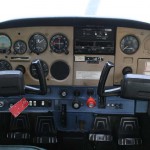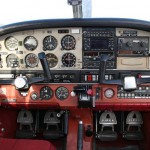So you’ve had lesson 1 – before we get to ‘flying’ lesson 2, there are some things to learn on the ground.
Taxiing – Ex5.
To fly a plane, you first must taxi to the runway! This is easier said than done, for example if you’re in a tail-dragger, taxiing can be very hard! We’ll assume you’re in a nice tricycle gear aircraft!
Before moving off – you must check where you want to go – what is the runway in use, your taxi route, and your holding point (where you will stop to do ‘power checks’ – we’ll get to those in a later lesson!). Ideally you’ll have a map of the aerodrome, and talk to air traffic control to get taxiing instructions.

Airports can be confusing, so be sure of your taxi-route.
Moving off – release brakes, rudder centralised, and open the throttle to get the aircraft to move. Once under-way reduce throttle to avoid accelerating. As soon as moving you must check the brakes work before you start going anywhere to quickly! Also once moving check your steering works in both directions. (These items should be on your checklist – if you’ve not got one yet, go and buy one! These lessons assume you are following the checklists appropriate to your aircraft).
Braking – using your toe brakes. Your heels should be on the pedals, tilting feet forward applies brakes. Reduce power when braking so you’re not pointlessly braking against engine thrust.
Steering – is achieved using your rudder pedals, under your feet. Right foot down plane turns right, left foot down plane turns left. Steering may be just via the rudder, or by a steering nose-wheel (usually on springs). Steering will be less immediate at low speeds. Using toe brakes on just one side of the aircraft can be useful for making tighter turns.
Control column – ‘dive away/climb into’ from the wind. I.e. be aware of where the wind is coming from, and make control column adjustments accordingly. Doing this will keep weight off the nose-wheel and keep you in control of the aircraft. ALSO – in general use backwards (upward) pressure on the yoke to keep weight off the nose-wheel – particularly when on rough ground and grass.
When taxiing it’s important to speak to ATC or ‘ground’ control at your aerodrome, and adhere to air laws.
Special situations and failures.
When crossing from smooth tarmac to rough grass, approach the transition at a 45 degree angle. Use this same approach is traversing a dip or lump of rough terrain.
Steering failure – gently brake, inform ATC, shut-down engine and await assistance.
Brake failure – shut off engine (throttle, mixture, magnetos, fuel) roll to a stop, steering to avoid collisions. If safe or possible, roll to stop in a safe place. Turning into wind can help slow.



